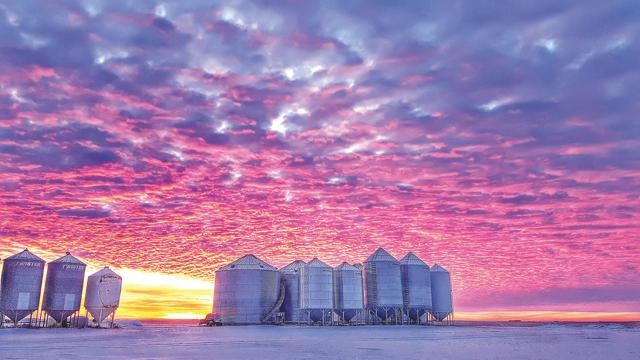Sarah Leguee loves the farming life and being an “agvocate” as she helps spread the word about what being a producer is all about, including taking photographs of the remarkable views of the landscapes she sees every day.
Leguee farms with her brother Jake and father Russ on 13,000 acres of land in the Fillmore area, and began photographing the views that greeted her whenever she was out driving a grain truck or a combine.
She is quick to point out she’s not a professional photographer by any means, and has no desire to photograph weddings or other events — she simply wants to share some of the beauty of the land that she gets to see every day.
“I see all this cool stuff, neat things that a lot of people don’t get to see,” she explained, noting that she uses her cell phone to take the photos. “If I’m in the field, I take them either from the tractor cab or I make a quick stop and jump out to take the photo, and I look at them later on.”
Sarah noted she has family in the city, and she likes sharing her photos with them so they can see what’s going on around the Leguee farm.
Her interest in taking photos started quite naturally, as she had a Polaroid camera as a young girl, and she loved taking photos around the farm. She found an old photo album with some of her photos from that time, such as the cattle pen or of kittens.
“We got a 7720 combine when I was a kid, and I was really excited about it and took photos of it,” said Sarah, chuckling. “I was probably around six years old.”
More recently, she became involved in an agriculture promotion by Farm Credit Canada, called “Ag More Than Ever”, which featured farmers as “agvocates” promoting the positive aspects of farming, and she has shared some of her photos that way.
“I’m just trying to show some of what we do at the farm with everybody, because there’s so many bad things out there and people don’t know what we really do,” said Sarah, noting that in a similar vein, her brother Jake writes a blog about being a young farmer. “You can get a sense of a day-to-day look at life on the farm.”
While each person on the farm has different strengths and abilities, “we all have the same goals, namely to grow safe good food and keep the land in good condition. … We’re all good at many different things, so we have a well-rounded team to manage and run our operation.”
Sarah had an off-farm job for six years, working at the John Deere dealership for most of that time, and before that she attended Olds College in Alberta for three years, earning two diplomas.
“It was more about meeting people. You do a lot of networking and I occasionally get to do business with college friends. At the dealership, I’ve gotten the chance to meet and deal with many producers in the area that I maybe wouldn’t have even met if I had gone straight back to the farm. When I went to ag college, it was during the BSE scare,” she said, noting things have changed for the better since then.
Sarah feels the off-farm work experience was valuable for her, noting she’s seen other kids go into other careers right out of high school rather than staying on the farm. “I learned a lot and met a lot of people through work. It gives you a good experience being on the other side of the counter,” she said.
Sarah is happy to be back working on the farm, as “there’s not a lot of places where you can work with your family every day. That doesn’t appeal to everyone, but it does to me. I also think it’s pretty cool working with big equipment. I get a lot of time in the sprayer, combine, semi or tractor.”
She added that even when she’s hanging out after work, she spends a lot of time with her family, and taking part in such activities as playing sports and driving in demolition derbies.
After being able to work outdoors and around the farm, Sarah said she could never work in an office all day.
“Obviously we see all kinds of cool stuff,” she said. “The ag industry is pretty diverse, and I’ve been lucky to meet all sorts of awesome people.”
The Leguees grow a variety of grains, pulses and oilseeds, after getting out of raising cattle a number of years ago. Depending on the year and what crop rotations are planned, they usually plant four to seven crops each growing season, including a lot of durum, winter wheat, spring wheat, canola, peas lentils, soybeans and occasionally flax.
Noting their land had lots of moisture last spring, “we were able to pull off a fairly decent crop, considering the conditions,” she said, referring to the extremely dry summer and fall.
Looking ahead to this coming spring, said Sarah, “We really won’t know till we get closer to seeding what the conditions will be like.”
A factor in their favour is that, unlike with the drought in the 1980s, they have much better agronomy practices to manage the challenges of a dry year if the southeast area doesn’t receive much more moisture by the spring.
“You can change things like the seeding depth and fertilizer, but in the end, you just have to do what you do and hope for the best,” said Sarah.




